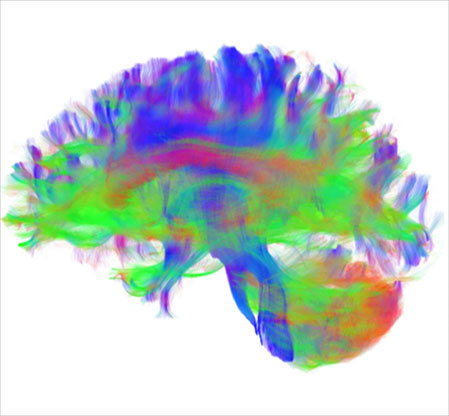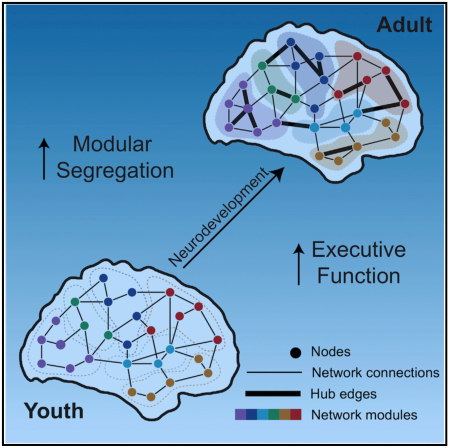Archived Content
The National Institute of Mental Health archives materials that are over 4 years old and no longer being updated. The content on this page is provided for historical reference purposes only and may not reflect current knowledge or information.
Connections Strengthen Within Specialized Networks as Brain’s Executive Function Matures
• Science Update
As we grow up, our brain’s specialized networks become more structurally segregated, contributing to improved executive functioning, NIMH-funded researchers have discovered. These densely interconnected “modules” process information for key functions that underlie development of mental control and self-regulation. The researchers traced long distance brain connections to identify age-related differences in structural connectivity within and between modules. They scanned a community-based sample of 882 participants, ages 8-22, using diffusion magnetic resonance imaging. Modules became more segregated with age as their connections to other modules declined during childhood and adolescence, while within-module connectivity increased with age. This increased segregation was associated with enhanced global efficiency provided by targeted strengthening of critical connections between modules. Segregation of a control system network between the frontal and parietal lobes was uniquely associated with improvements in executive functioning. The structural changes parallel functional changes discovered earlier. The findings may improve understanding of teen risk-taking and mental illnesses associated with executive system dysfunction – and may help identify biomarkers of risk and resilience, say researchers. A team of investigators led by Drs. Danielle Bassett and Theodore Satterthwaite at the University of Pennsylvania report on their findings online in Current Biology May 24, 2017.
"We were surprised to find that the development of structural brain networks involved both more distinct modules but also more global integration across the brain," Satterthwaite said.

Diffusion image shows long distance connections in brain of study participant.
Source: Penn Medicine

Connections strengthen within brain specialized networks as we grow up, improving executive function.
Source: Penn Medicine
For more information
As Brains Mature, More Robust Information Networks Boost Self-Control
NPR story (includes sound bites from NIMH director Dr. Joshua Gordon)
(transcript )
Reference
Modular Segregation of Structural Brain Networks Supports the Development of Executive Function in Youth. Baum GL, Ciric R, Roalf DR, Betzel RF, Moore TM, Shinohara RT, Kahn AE, Vandekar SN, Rupert PE, Quarmley M, Cook PA, Elliott MA, Ruparel K, Gur RE, Gur RC, Bassett DS, Satterthwaite TD. Curr Biol. 2017 May 24. pii: S0960-9822(17)30496-7. doi: 10.1016/j.cub.2017.04.051. [Epub ahead of print] PMID: 28552358
Grants
MH107703, MH106799, MH107235, DC009209, HD086888, MH089983, MH089924, MH107235, MH102609, MH097891, NS085211
